| |
When
war seemed imminent the Ottoman Empire (Turkey) attempted to ally
herself with the 'Entente'. On receiving a negative response to
this she found herself obliged to join the Alliance of Germany and
Austria-Hungary. A treaty was signed on 2nd August 1914. This has
been seen as a failure of British diplomacy. However, the Ottoman
Empire was not ready for war so it was decided to keep the treaty
with Germany secret and adopt a stance of neutrality. The Ottoman
Empire had the Dardanelles and the Bosporas. These straits between
the Black Sea and the Mediterranean have been militarily strategic
historically and no less so now for they represented for Britain
and France a warm water route to their ally Russia. Russia needed
war materials, Britain needed Russian wheat and there were 120 Allied
merchant vessels in the Black sea. |
|
|
| |
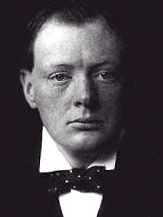 Winston Churchill
1918
Winston Churchill
1918 |
First
Lord of the Admiralty, Winston Churchill and his colleagues in
the war cabinet were acutely aware of all this as also were the
Germans who needed greatly to change the direction of the war.
If the Ottoman Empire entered the war, Germany's load would be
decreased. So Germany decided to take some measures. Two German
Warships then in the Mediterranean under the command of Rear Admiral
Wilhelm Souchon, anchored at the entrance to the Canakkale Straits
on the 10th August 1914. After much discussion the 'Goeben' and
the ' Breslau' were accepted by the Ottoman Empire and an announcement
made that they had been 'purchased' from Germany. |
|
| |
Lord
Fisher, Churchill's First Sea Lord entered the navy in 1854. He
was responsible for instituting the developmental work that perfected
the torpedo, the building of the first modern all-big-gun battleship,
the Dreadnought, encouraged the development of submarines and supervised
the conversion of the navy from coal-fired to oil-fired steam power.
His reforms proved crucial to Britain's wartime naval supremacy.
He opposed the Dardanelles expedition. |
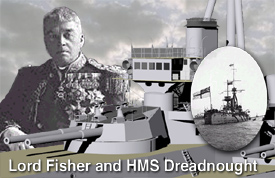 Model: www.dreadnoughtproject.org/
Model: www.dreadnoughtproject.org/ |
|
| |
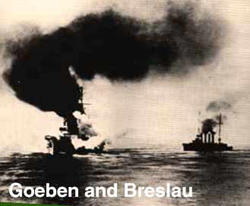 |
On
arrival in the straits, Rear Admiral Souchon lost no time in inspecting
the Turkish 'fortresses'. He found poorly trained Turkish gunners
with out-of-date equipment (old guns of different calibre and type,
with poor range finding, fire observation and control).
He requested additional support, and approximately four hundred
naval artillerymen and mine warfare experts under the command of
Vice Admiral Guido von Usedom were dispatched to Turkey. These men
were integrated into the Turkish service, (with the concurrence
of Kaiser Wilhem II ) to maintain the appearance of Turkish neutrality. |
|
| |
Vice Admiral Usedom reported that there was not adequate large calibre
ammunition to meet more than one major assault so he expanded the
Turkish Mining effort creating a minefield of 343 mines in ten lines
and spaced at regular intervals over a ten thousand yard approach
to the narrowest part of the Dardanelles. These mines were defended
by the fixed guns of the intermediate forts and by mobile battery.
|
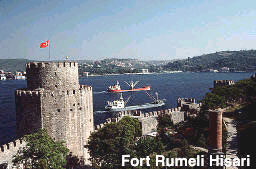
An example
of a Fort located on the Bosphorous
|
|
| |
|
After
the announcement of the 'purchase' the name of the 'Goeben' was
changed to "Yavuz' and the 'Breslau' became 'Midilli'. Uniforms
of the soldiers were changed. The two ships sailed on to Istanbul
carrying the flag of the Ottoman Empire.

During this
time British and French ships were waiting in front of the straits
for the two German Warships to emerge. On the orders of the Turkish
General Enver, leader of the political party 'Ittihat ve Terakki'
( "Union and Progress" ) concerned with the military affairs of
the Ottoman Empire, these ships then sailed on to Russia.
General Enver was under considerable German pressure.
He had a plan. |
|
| |
On
29th October 1914, the warships attacked the Russian Harbours of
Odesa, Navroski and Sebastopol. Russia declared war immediately
on the Ottoman Empire. Four days later Britain and France declared
war and then on Nov 3rd 1914 shelled the guns at the entrance to
the strait. (Sebdulbahir). Finally the Ottoman empire abandoned
its stance of neutrality and replied with their declaration of war.
After the post WW1 Allied carve up of the Ottoman empire it was
General Enver who was blamed for initiating its demise.
|
|
|
| |
|
On
the 3rd January 1915, Winston Churchill asked Admiral Sir Sackville
Carden, commander of the combined British and French battle squadron
in the Mediterranean, "Do you consider the forcing of the Straits
by ships alone a practical operation?' He added " Importance of
result would justify severe loss!" Kitchener already had this view
as did Prime Minister Herbert Asquith. |
|
| |
|
So
the plan which had been around since 1904 but both military and
naval opinion was against it was accepted to force the straits by
destroying the Turkish defences. The Australians role in this, by
reason of the fact that they were untried troops, was to Garrison
the forts as they were captured. Mobilisation began. Troops were
gathered in preparation on the Greek Island of Lemnos. Turkish reconnaissance
planes observed this daily so the Turks were very much aware of
the numbers and strength of the forces gathering. Long range operations
commenced on 19th February but were less than effective succeeding
only in silencing the outer forts. Bad weather caused other delays
and on the 9th March Admiral Carden reported to Churchill that he
would concentrate on clearing the mines. Long range operations could
not knock out the inner- forts. The mine-sweeping operations at
night, manned by civilians were less than successful. This led Admiral
Carden to plan a daylight attack to silence the intermediate and
inner forts and permit the minelines to be swept. The order was
given on 17th March by second in command, Admiral Sir John de Robeck.
Admiral Carden had been relieved due to ill-health. |
|
| |
On
March 18th,1915 the Allied fleet made its greatest attack at the
Dardanelles which proved disastrous to the Allies. The outcome was
the sinking of the Bouvet, the Ocean, and the Irresistible and the
serious crippling of four other vessels. The
Turkish people remember this day as a great national victory,
when the Allied warships were turned back by the bravery and steadfastness
of the Turkish gunners of the Dardanelles forts. Here below is
Gallipoli on that day, a month prior to the Australian landing.
Please note the Railway tracks..
|
|
|
| |
 |
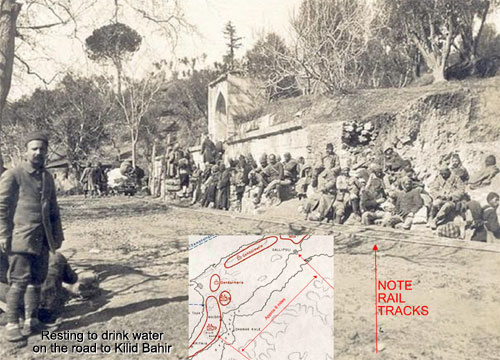
About 6 miles
along the coast from Gallipoli is Kilid Bahir. Obviously, the
rail tracks continued along the coast. These photos are by courtesy
of Evren Isikozlu from Istanbul and perhaps have not been seen
before in Australia.
|
|
| |
 |
|
|
| |
March
18th 1915. The operation began at 11.30. The battleships silenced
the forts and at approximately 1600 hours the trawlers moved forward
to begin sweeping- only to withdraw again under fire from the mobile
batteries. By the end of the afternoon the British and French had
lost six of their eighteen battleships. Admiral de Robeck's after
action report stated that he intended to renew the attack within
three or four days, after a re-organisation of the minesweeping
force which was now to be manned by volunteers from the battleships
survivors. Two more battleships were dispatched to de Robeck with
instructions: "It appears important not to let the forts be repaired
or to encourage the enemy by an apparent suspension of the operation'.
|
|
|
| |
|
On
23 March Admiral de Robeck completely reversed his plan of action.
After a conference with the senior Army officer on the scene (General
Sir Ian Hamilton), de Robeck proposed a joint operation in which
the Army would secure the forts before the Navy tried to force
a passage.
Sir Ian Hamilton
later commanded the Gallipoli campaign from on board HMS Queen
Elizabeth. His role throughout the campaign was brought under
scrutiny. Military
censorship prevented the true story being told but a young Australian
journalist, Keith Murdoch smuggled the story about the scale of
the Dardanelles disaster back to the Australian Prime Minister
who sent it on to the British Prime Minister David Lloyd George,
who was no friend of the British military establishment. It led
directly to the dismissal of Sir Ian Hamilton who never again
was to hold a senior military position. |
|
| |
|
|
|
| |
After
Admiral de Robeck's reversal, Lord Fisher then changed his own
position, refusing to challenge the judgment of the on-scene commander.
Even with the support of Prime Minister Asquith and Lord Kitchener,
Churchill could not get the cabinet to order de Robeck to renew
the attack immediately.
Lord Fisher
resigned from the Admiralty.
The
decision to conduct a ground campaign led to the disaster known
as Gallipoli. |
|
|
| |
"For
nearly six weeks, nothing of importance occurred at the Dardanelles.
In spite of the dramatic warning given by the brief bombardment,
the work of repairing the forts and garrisoning the area was not
carried for ward energetically. On December 13th Mr. Engert, the
American vice- consul at Chanak, was enjoying the warm morning
in a small rowing boat in the Straits when the old battleship
Messudieh, anchored south of Chanak in Sari Sighlar Bay, was suddenly
rent with a gigantic explosion and sank in under seven minutes.
The tiny British submarine BII, only 143 feet long and with a
maximum submerged speed of 6.5 knots, manned by two officers and
eleven ratings, eventually limped out of the Straits to the open
sea, safety, and the first submarine V.C. for her commander, Lt.
Holbrook. RN."
Source:
Robert Rhodes James: "Gallipoli"

|
|
| |
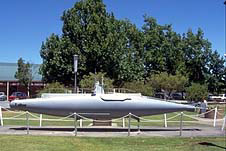 Scale model
of the BII submarine
Scale model
of the BII submarine
Commander Holbrook Memorial Park
Holbrook NSW Australia |
|
| |
At
home in Australia people were busy knitting
socks and making Anzac biscuits to send to the troops, and renaming
everything remotely German to something more acceptable, German
sausage became 'Devon' sausage for instance and whole towns were
renamed, such as the following:
Thought to be occupied by the Wiradjuri people prior to European
settlement theTown of Holbrook, on the South West Slopes NSW, has
had many names. Hume and Hovell (1824) called it Friday Mount and
Camden Forest. In 1836 it was known as Therry's or Billabong. The
first district leases were granted in 1836-37 and the first resident
was German-born Johann Pabst who had arrived in Australia in 1825
as a sheep expert working for the Australian Agricultural Company.
He settled here with his family in 1838.
The emergent settlement was known as 'The Germans' and a town reserve
was declared in 1848. In 1876 the settlement was officially gazetted
as 'Germanton'.
In 1914 the locals didn't like the name particularly considering
the war in Europe and so the name was changed to Holbrook after
Submarine Commander Norman Douglas Holbrook. Today a scale Model
of the BII stands proudly in the town as tribute to Commander Holbrook's
skill and daring which a German naval officer ruefully admitted
to the enthralled Mr. Engert was, "a mighty clever piece of work".
|
|
| |
Stoker's
Submarine
|
|
|
Also
nearby in the same park is a Mark VIII torpedo, commemorating
the actions in World War 1 of Lieutenant H. Stoker, D.S.O., RX,
and the crew of the RAN Submarine HMAS AE2. this submarine operated
in the Marmara until April 30th 1915, when she was sunk, after
a two hours fight, by a Turkish torpedo-boat.
Lt.-Commander Stoker's account of AE2's exploits, "Straws
in the Wind", is one of the classics of submarine warfare.
. ( and very hard to find..)
A
new book, "Stoker's Submarine", by Fred and Elizabeth
Brenchley, is being launched on April 19, 2001 at Garden Island
with Opposition Leader Kim Beazley doing the honours.

|
|
| |
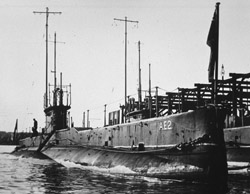
AE2 in dock at Garden Island. Sydney. NSW |
|
| |
The AE2's
penetration into the Sea of Marmara played a highly significant
and perhaps pivotal role in the outcome of the Gallipoli campaign.
Her Commanding Officer Lieutenant Commander Harry Stoker, had
written orders to penetrate the Dardanelles. He was to '...take
measures necessary to block enemy traffic' and, if he succeeded
in reaching Chanak (opposite Gallipoli), he should try to sink
any mine-dropping vessels and 'run amok generally'. He did just
that and torpedoed and sunk a small cruiser.
After the
first day of troop embarkation, 25th April 1915, there was much
discussion amongst senior officers about withdrawal. It was a
time of decision for Sir Ian Hamilton considering the heavy casualties.
The news of the AE2's success roused the optimism of the commanding
officers, and is probably a factor in influencing Hamilton's decision.
On the night of the 25th April 1915 he wrote to the troops:
|
|
| |
"Your
news is indeed serious. But there is nothing for it but to dig yourselves
right in and stick it out. It would take at least two days to re-embark
you as Admiral Thursby will explain to you. Meanwhile, the Australian
submarine AE2 has got up through the Narrows and has torpedoed a
gun-boat at Chunuk (sic). Hunter-Weston despite his heavy losses
will be advancing tomorrow which should divert pressure from you.
Make a personal appeal to your men and Godley's to make a supreme
effort to hold their ground. lan Hamilton.
P.S. You have got through the difficult business, now you have only
to dig, dig, dig, until you are safe. lan H." |
|
| |
|
|
The
AE2 now lies at 72 metres in the Sea of Marmara. Efforts to
raise the submarine are a collaborative effort between Turkish
individuals supervised by Selçuk Kolay, of the Rahmi M. Koç
Museum, who discovered the wreck and our Australian team led
by Dr.Mark Spencer considered the Australian authority on
deep shipwreck photography. |
|
|
|
| |
|
|
| |
The
Black Sea A Russian Perspective
HERE
|
|
| |
|
|
|